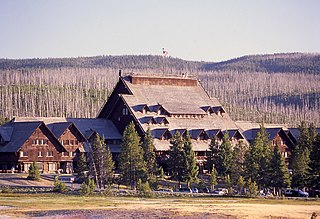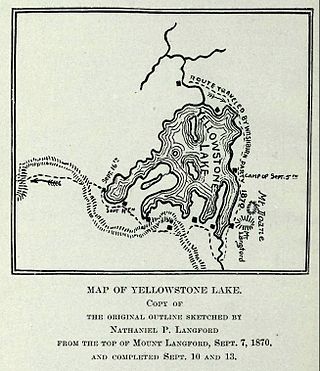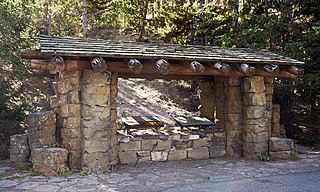
The Old Faithful Inn is a hotel in the western United States with a view of the Old Faithful Geyser, located in Yellowstone National Park, Wyoming. The Inn has a multi-story log lobby, flanked by long frame wings containing guest rooms. In the western portion of the park, it sits at an approximate elevation of 7,350 feet (2,240 m) above sea level.

Fort Yellowstone was a U.S. Army fort, established in 1891 at Mammoth Hot Springs in Yellowstone National Park. Yellowstone was designated in 1872 but the Interior Department was unable to effectively manage the park. Administration was transferred to the War Department in August 1886 and General Philip Sheridan sent a company of cavalry to Mammoth Hot Springs to build a cavalry post. The army originally called the post Camp Sheridan in honor of General Sheridan but the name was changed to Fort Yellowstone in 1891 when construction of the permanent fort commenced. The army administered the park until 1918 when it was transferred to the newly created National Park Service. The facilities of Fort Yellowstone now comprise the Yellowstone National Park headquarters, the Horace Albright Visitor Center and staff accommodations.

National Park Service rustic – sometimes colloquially called Parkitecture – is a style of architecture that developed in the early and middle 20th century in the United States National Park Service (NPS) through its efforts to create buildings that harmonized with the natural environment. Since its founding in 1916, the NPS sought to design and build visitor facilities without visually interrupting the natural or historic surroundings. The early results were characterized by intensive use of hand labor and a rejection of the regularity and symmetry of the industrial world, reflecting connections with the Arts and Crafts movement and American Picturesque architecture.

The Washburn Expedition of 1870 explored the region of northwestern Wyoming that two years later became Yellowstone National Park. Led by Henry D. Washburn and Nathaniel P. Langford, and with a U.S. Army escort headed by Lt. Gustavus C. Doane, the expedition followed the general course of the Cook–Folsom–Peterson Expedition made the previous year.

Yellowstone National Park has over 1,100 miles (1,800 km) of blazed and mapped hiking trails, including some that have been in use for hundreds of years. Several of these trails were the sites of historical events. Yellowstone's trails are noted for various geysers, hot springs, and other geothermal features, and for viewing of bald eagles, ospreys, grizzly bears, black bears, wolves, coyotes, bighorn sheep, pronghorns, and free-ranging herds of bison and elk.

Herbert Maier was an American architect and public administrator, most notable as an architect for his work at Yosemite, Grand Canyon and Yellowstone National Parks. Maier, as a consultant to the National Park Service, designed four trailside museums in Yellowstone, three of which survive as National Historic Landmarks. Maier played a significant role in the Park Service's use of the National Park Service Rustic style of architecture in western national parks.

The Fishing Bridge Museum is one of a series of "trailside museums" in Yellowstone National Park, Wyoming, United States, designed by architect Herbert Maier in a style that has become known as National Park Service Rustic. It is one of three parts of a 1987-declared National Historic Landmark, the Norris, Madison, and Fishing Bridge Museums. It was not listed separately on the National Register of Historic Places as the other two were. Built in 1931, the Fishing Bridge Museum is the largest in the series, and is used as a small visitor center. The museum displays stuffed mounts of birds and animals found in Yellowstone Park.

The Norris Geyser Basin Museum, also known as Norris Museum, is one of a series of "trailside museums" in Yellowstone National Park designed by architect Herbert Maier in a style that has become known as National Park Service Rustic. It is listed on the National Register of Historic Places, and is one of three parts of a National Historic Landmark, the Norris, Madison, and Fishing Bridge Museums, which were funded by Laura Spelman Rockefeller's grant of $118,000. Built 1929 - 1930, the Norris Museum is sited on a hill between the Porcelain Basin and the Back Basin of Norris Geyser Basin. Its central breezeway frames a view of the Porcelain Basin for arriving visitors.

The Norris, Madison, and Fishing Bridge Museums are three "trailside museums" within Yellowstone National Park in the western United States. Built in 1929 to designs by Herbert Maier, they are preeminent early examples of the National Park Service Rustic style of architecture, and served as models for the construction of park buildings elsewhere in the park system in the 1930s. They were collectively designated a National Historic Landmark in 1987.

The Obsidian Cliff Kiosk is a small structure that shelters an interpretive exhibit in Yellowstone National Park at Obsidian Cliff. The kiosk was built in 1931 as part of an effort to provide interpretive exhibits along the park's Grand Loop Road. In common with the Fishing Bridge Museum, Madison Museum and Norris Museum, the kiosk exemplifies the National Park Service Rustic style. The interpretive exhibit was designed by National Park Service's Carl Russell, who provided many other innovations in visitor experiences.

The Grand Loop Road is a historic district which encompasses the primary road system in Yellowstone National Park. Much of the 140-mile (230 km) system was originally planned by Captain Hiram M. Chittenden of the US Army Corps of Engineers in the early days of the park, when it was under military administration. The Grand Loop Road provides access to the major features of the park, including the Upper, Midway and Lower geyser basins, Mammoth Hot Springs, Tower Fall, the Grand Canyon of the Yellowstone and Yellowstone Lake.

The Old Faithful Historic District in Yellowstone National Park comprises the built-up portion of the Upper Geyser Basin surrounding the Old Faithful Inn and Old Faithful Geyser. It includes the Old Faithful Inn, designed by Robert Reamer and is itself a National Historic Landmark, the upper and lower Hamilton's Stores, the Old Faithful Lodge, designed by Gilbert Stanley Underwood, the Old Faithful Snow Lodge, and a variety of supporting buildings. The Old Faithful Historic District itself lies on the 140-mile Grand Loop Road Historic District.

Hamilton's Stores were concessioners in Yellowstone National Park from 1915 to 2002. The stores were founded by Winnipeg native Charles Hamilton, who arrived in Yellowstone in 1905, aged 21, to work for the Yellowstone Park Association. The stores provided tourists with food, souvenirs, and sundries at the major attractions along Yellowstone's Grand Loop Road. Several buildings constructed for Hamilton are significant examples of the National Park Service Rustic style of architecture and have assumed prominence as attractions in their own right. Most are included as contributing structures in National Register of Historic Places historic districts.

The Lake Fish Hatchery Historic District comprises nine buildings built between 1930 and 1932 by the U.S. Fish and Wildlife Service in the National Park Service Rustic style. The buildings exhibit a consistency of style and construction, with exposed gable trusses and oversized paired logs at the corners, all with brown paint. The district is located on the shore of Yellowstone lake near the Lake Hotel The hatchery was established to provide Yellowstone cutthroat trout eggs for state and federal hatcheries outside Yellowstone.

The Roosevelt Lodge Historic District comprises the area around the Roosevelt Lodge in the northern part of Yellowstone National Park, near Tower Junction. The district includes 143 buildings ranging in size from cabins to the Lodge, built beginning in 1919. The Lodge was first conceived as a field laboratory for students and educators conducting research in the park. It later became a camp for tourists, specifically designed to accommodate automobile-borne tourists. The Lodge is a simplified version of the National Park Service Rustic style.

The Mammoth Hot Springs Historic District is a 158-acre (64 ha) historic district in Yellowstone National Park comprising the administrative center for the park. It is composed of two major parts: Fort Yellowstone, the military administrative center between 1886 and 1918, and now a National Historic Landmark, and a concessions district which provides food, shopping, services, and lodging for park visitors and employees. It was added to the National Register of Historic Places on March 20, 2002, for its significance in architecture, conservation, entertainment/recreation, and military. The district includes 189 contributing buildings.

The following articles relate to the history, geography, geology, flora, fauna, structures and recreation in Yellowstone National Park.

The bibliography of Yellowstone National Park identifies English language historic, scientific, ecological, cultural, tourism, social, and advocacy books, journals and studies on the subject of Yellowstone National Park topics published since 1870 and documented in Yellowstone related bibliographies and other related references.
The Old Faithful Museum of Thermal Activity was one of a series of four "trailside" museums built in Yellowstone National Park in 1929. Funded by a grant of $118,000 from Laura Spelman Rockefeller, the museums interpreted park features for visitors, and represented an early version of the visitor information center concept that became widespread throughout the National Park Service. The four museums were notable examples of the National Park Service Rustic style, and all were designed by Park Service architect Herbert Maier. The surviving Norris Museum, Fishing Bridge Museum and the Madison Museum are collectively listed as National Historic Landmarks.
This is a list of the National Register of Historic Places listings in Yellowstone National Park.



















